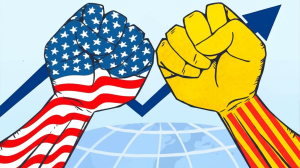
Decoding Dalio: A Deep Dive into America’s Fiscal Predicament
Ray Dalio, the founder of Bridgewater Associates, the world’s largest hedge fund, has emerged as a prominent voice warning of the impending economic challenges facing the United States. His warnings, often framed in urgent and stark terms, depict a nation on the brink of financial collapse due to its burgeoning debt. As a figure of significant influence in the financial world, Dalio’s pronouncements carry weight, but they also warrant careful scrutiny. This report will explore Dalio’s concerns, analyze the underlying data, and assess the potential pathways forward for the U.S. economy.
The Alarming Diagnosis: A Financial “Heart Attack”
Dalio’s warnings are not merely alarmist rhetoric; they are grounded in a deep understanding of economic principles and historical precedents. He frequently describes the U.S. debt crisis as a potential “financial heart attack” or a “debt death spiral,” metaphors that underscore the severity of the situation. His concerns are rooted in three primary factors: the sheer size of the national debt, the escalating costs of servicing that debt, and the political paralysis that prevents meaningful corrective action.
The numbers are indeed alarming. The national debt has surpassed $36 trillion, with the debt-to-GDP ratio exceeding 120%. Annual budget deficits consistently run in the trillions, further exacerbating the problem. The cost of servicing this debt is projected to approach $900 billion annually, a figure that is increasingly crowding out other crucial government spending, such as infrastructure, education, and research.
Dalio highlights the lack of political will to address these issues. He notes that despite a general consensus among policymakers about the need for change, concrete actions remain elusive. This inaction, he argues, stems from the painful choices that would be necessary to rein in the debt, including spending cuts, tax increases, or a combination of both. These measures are politically unpopular and could potentially trigger economic slowdowns, making them difficult for elected officials to embrace.
The Root Causes: A Perfect Storm of Spending and Inaction
The U.S. debt crisis is not a recent phenomenon. It is the culmination of decades of fiscal policies marked by excessive spending, insufficient revenue, and a reluctance to confront difficult choices. Several key factors have contributed to the current situation:
Persistent Budget Deficits
The U.S. has consistently run budget deficits for decades, meaning that the government spends more than it collects in revenue. These deficits are often fueled by tax cuts, increased spending on social programs, or military expenditures. The persistent nature of these deficits has led to a cumulative debt that now poses a significant threat to economic stability.
Tax Cuts
While tax cuts can stimulate economic growth in the short term, they also reduce government revenue, contributing to larger deficits. The Tax Cuts and Jobs Act of 2017, for example, significantly lowered corporate and individual income taxes, adding trillions to the national debt. The long-term effects of these tax cuts have been a subject of debate, with some arguing that they have not generated sufficient economic growth to offset the increased debt.
Entitlement Programs
Social Security and Medicare, while vital for providing social safety nets, represent significant long-term financial obligations. As the population ages and healthcare costs continue to rise, these programs are placing increasing strain on the federal budget. Reforming these programs is a politically sensitive issue, as any changes could impact millions of Americans who rely on these benefits.
Wars and Military Spending
The U.S. has engaged in numerous costly military conflicts over the past several decades, adding trillions to the national debt. The wars in Iraq and Afghanistan, in particular, have been enormously expensive, both in terms of human lives and financial resources. The long-term impact of these conflicts on the national debt is a topic of ongoing debate, with some arguing that the benefits of these interventions have not justified the costs.
Economic Downturns
Recessions and economic slowdowns can lead to decreased tax revenue and increased spending on unemployment benefits and other social safety net programs, further exacerbating budget deficits. The COVID-19 pandemic, for example, led to a significant increase in government spending and a corresponding rise in the national debt. The long-term effects of this spending are still being assessed, but it is clear that it has contributed to the current debt crisis.
Political Polarization
The increasing political polarization in the U.S. has made it difficult to reach bipartisan consensus on fiscal policy. Democrats and Republicans often have fundamentally different views on taxes, spending, and the role of government, making it challenging to enact meaningful reforms. This polarization has led to a gridlock that prevents the implementation of policies that could address the debt crisis.
The Potential Consequences: A Cascade of Economic Pain
Dalio warns that the U.S. debt crisis could trigger a cascade of negative economic consequences. These include:
Higher Interest Rates
As the U.S. government borrows more money, it puts upward pressure on interest rates. Higher interest rates can make it more expensive for businesses to borrow money, potentially slowing economic growth and leading to job losses. The Federal Reserve’s role in managing interest rates is crucial, but the increasing debt burden could limit the Fed’s ability to respond to economic crises effectively.
Inflation
If the Federal Reserve attempts to monetize the debt by printing more money, it could lead to inflation. Inflation erodes the purchasing power of consumers and can destabilize the economy. The recent surge in inflation has already highlighted the challenges of managing monetary policy in the face of a growing debt burden.
Dollar Devaluation
A growing debt burden could erode confidence in the U.S. dollar, leading to its devaluation. A weaker dollar would make imports more expensive, further fueling inflation. The U.S. dollar’s status as the world’s reserve currency is a significant advantage, but a loss of confidence in the dollar could have far-reaching consequences for the global economy.
Reduced Government Spending
As the cost of servicing the debt rises, the government may be forced to cut spending on other essential programs, such as education, infrastructure, and research. This could have long-term negative consequences for the economy. Investments in these areas are crucial for long-term economic growth, and reducing spending could hinder the U.S.’s ability to compete globally.
Financial Crisis
In a worst-case scenario, the U.S. debt crisis could trigger a financial crisis, similar to the one that occurred in 2008. A loss of confidence in the U.S. government’s ability to repay its debts could lead to a sell-off of U.S. Treasury bonds, causing interest rates to spike and potentially triggering a recession. The global interconnectedness of financial markets means that a U.S. financial crisis could have ripple effects around the world.
Possible Solutions: Navigating a Thorny Path
Addressing the U.S. debt crisis will require a multi-faceted approach involving a combination of spending cuts, tax increases, and structural reforms. There are no easy solutions, and any meaningful action will likely be politically painful. Some potential strategies include:
Spending Cuts
Identifying areas where government spending can be reduced without jeopardizing essential services is a complex task. This could involve cutting discretionary spending, reforming entitlement programs, or reducing military expenditures. The challenge lies in balancing the need for fiscal responsibility with the importance of maintaining critical government functions.
Tax Increases
Raising taxes on corporations and high-income earners to increase government revenue is a contentious issue. This could involve raising income tax rates, increasing capital gains taxes, or implementing a carbon tax. The political and economic implications of these measures are significant, and their impact on economic growth and investment must be carefully considered.
Entitlement Reform
Making changes to Social Security and Medicare to ensure their long-term solvency is a politically sensitive issue. This could involve raising the retirement age, reducing benefits, or increasing payroll taxes. The challenge is to implement reforms that maintain the integrity of these programs while addressing their long-term financial viability.
Economic Growth
Implementing policies to promote economic growth is crucial for increasing tax revenue and helping to reduce the debt burden. This could involve investing in education, infrastructure, and research, as well as reducing regulations and promoting free trade. The long-term benefits of these investments must be weighed against the immediate need to address the debt crisis.
Bipartisan Cooperation
Reaching a bipartisan consensus on fiscal policy is essential for ensuring that any reforms are sustainable and politically viable. This will require compromise and a willingness to put the long-term interests of the country ahead of short-term political gains. The current political climate makes this a significant challenge, but it is a necessary step for addressing the debt crisis effectively.
A Call to Action: Avoiding the Abyss
Ray Dalio’s warnings, while stark, serve as a crucial wake-up call. The U.S. debt crisis is a serious threat to the nation’s economic future, and it demands immediate attention. While the path forward is fraught with challenges, inaction is not an option. By embracing fiscal responsibility, promoting economic growth, and fostering bipartisan cooperation, the U.S. can avert a financial catastrophe and secure a more prosperous future for generations to come. The time to act is now, before the “heart attack” becomes unavoidable.





